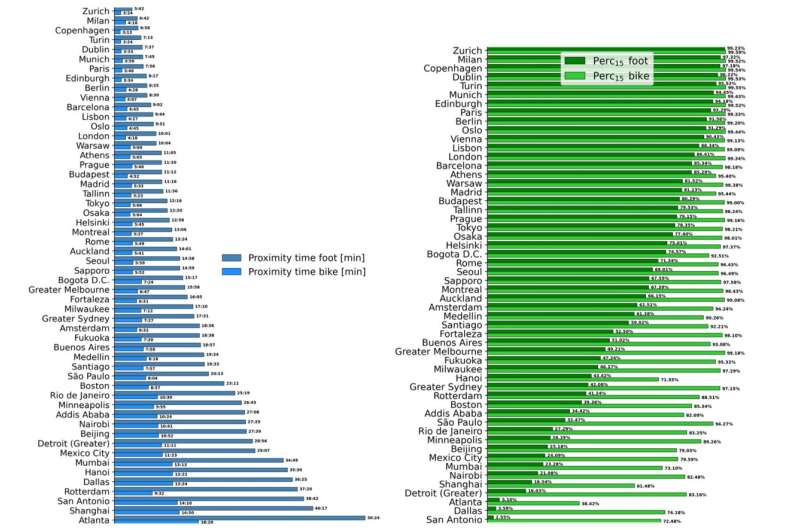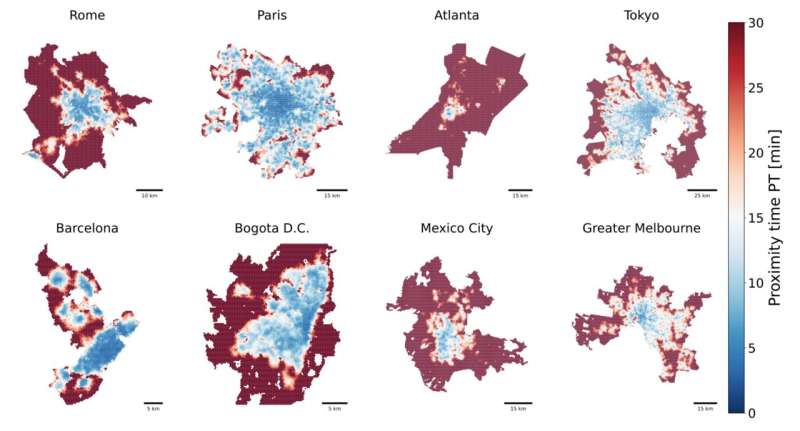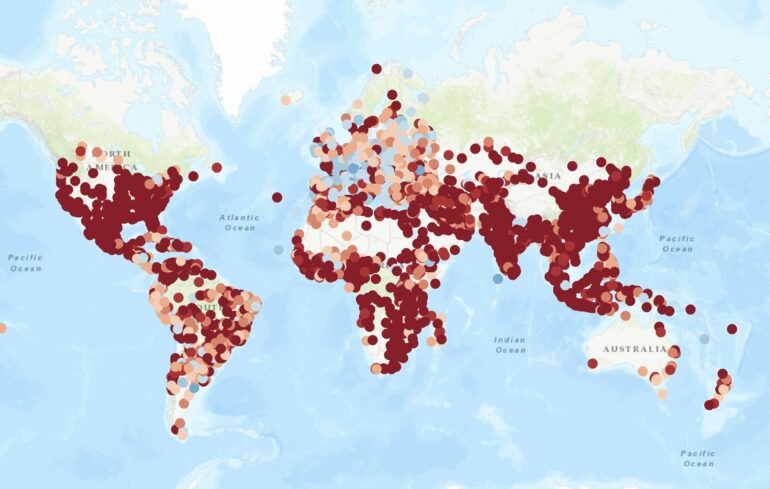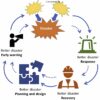The 15-minute city, a concept where essential services are accessible within a 15-minute walk or bike ride, has become increasingly popular in urban planning in recent years. This is because it offers solutions to several pressing challenges in urban areas, such as traffic, pollution, social isolation, and quality of life. With more than half of the world’s population now living in cities—and this figure steadily increasing—these issues are becoming ever more critical.
In a recent study, published in Nature Cities, researchers now provide a worldwide quantification of how close cities are to the ideal of the 15-minute city.
This research team, led by Vittorio Loreto, external faculty member at the Complexity Science Hub, Professor at Sapienza University of Rome and Director and head of the Sustainable Cities Research Line at of the Sony Computer Science Laboratories—Rome (Sony CSL—Rome), then adopted this metric to assess the status of many cities worldwide, and provided an open-access platform (whatif.sonycsl.it/15mincity) for everyone to explore cities or portions of them.
A global perspective on city accessibility
Using this new metric, the team evaluated and compared cities across the globe. “Our results revealed stark disparities in access to services, both within cities and between different regions, meaning that urban areas present a high level of inequality,” explains Loreto. For example, areas with many services in a city could be more expensive and only those who can afford it are able to live there.
“On a global scale, many cities in Europe score highly in terms of accessibility, with Vienna being a prime example. However, most of the cities in the U.S., Africa, and parts of Asia require significantly longer times to access basic services,” says Loreto.

The left plot shows the ranking of the average proximity time of the cities, both by bike and on foot, while the right one describes the percentage of people living in a 15-minute city. © Sony Computer Science Laboratories—Rome, Joint Initiative CREF-SONY
The research team didn’t stop at identifying these disparities but went a step further: what if the same resources and services were redistributed? Would it be possible to increase the accessibility, which would lead to less inequality in a city? Or does it require more resources? In short: Does a neighborhood, for example, need a massive transportation enhancement to reach essential services or a more capillary distribution of essential proximity services?
The relocation algorithm
The researchers tried to answer these questions by creating a “relocation algorithm,” which will help understand how to increase the number of citizens who can access services in a given urban area and reduce inequalities. In addition, the algorithm is also essential in simulating how a city would respond to an increase in services until it reaches the 15-minute framework and how the number of needed services can vary among different cities.
“We observe considerable differences between cities in terms of the minimum number of additional services required to fulfill the 15-minute city concept. Even more interesting, we observe that the very notion of a proximity-based city is not even conceivable in many cases, and a radically new paradigm has to be conceived,” says Loreto.

Each hexagon in each city is colored according to its proximity time (PT). Blueish (reddish) colors indicate areas with service accessibility times below (above) 15 minutes. There are notable differences between cities. A small fraction of Atlanta’s city area has PTs less than 15 minutes. By contrast, Paris has a significant portion of its city area below 15 minutes. © Sony Computer Science Laboratories – Rome, Joint Initiative CREF-SONY
Beyond time: Toward value-based city planning
Why is all this important? Fundamentally, it helps us better understand the cities we inhabit, the complex challenges residents face, and the diverse potential solutions. It also highlights that no two cities are alike, meaning each requires unique, tailored approaches to its complexities. The 15-minute city is just one of many frameworks that can help address these challenges.
In the study, the researchers concluded, that the merely time-based ideal of a city is not enough to create a livable city. Instead, we should start to create value-based cities, where local population densities, socio-economic and cultural factors are taken into account.
By utilizing such a model, urban planners, engineers, and policymakers can focus on creating customized solutions for their cities rather than one-size-fits-all approaches. This ensures cities become more accessible to a broader range of people. Building more equitable cities has vast advantages.
Better access to health care, education, culture, amenities, and the many opportunities cities offer as hubs of human creativity contribute to making us more engaged and informed global citizens.
More information:
Matteo Bruno, A universal framework for inclusive 15-minute cities, Nature Cities (2024). DOI: 10.1038/s44284-024-00119-4. www.nature.com/articles/s44284-024-00119-4
Provided by
Complexity Science Hub Vienna
Citation:
The 15-minute city: Why time shouldn’t be the only factor in future city planning (2024, September 16)



